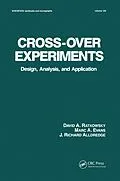Developing a model-based approach that enables any cross-over trial, of any degree of imbalance, to be analyzed both for direct effects and for residual effects, using consistent procedures that employ commercially available statistical software, this text offers a guide to the analysis of cross-over designs.;Illustrating practical applications throughout with examples, this book: emphasizes the importance of choosing highly efficient designs that separate treatment and carryover effects; demonstrates the exact methodology needed to handle the analysis of data; presents a new methodology for the analysis of binary and categorical data; and considers the effects of blocking. The appendices facilitate the choosing of an appropriate design for every experimental need.
Autorentext
DAVID A. RATKOWSKY is a former Assistant Professor of Statistics at Washington State University, Pullman. A member of the Biometric Society, he is the author of the Handbook of Nonlinear Regression Models and Nonlinear Regression Modeling: A Unified Practical Approach (both titles, Marcel Dekker, Inc.) and the author or co-author of more than 80 professional papers. He received the B.Ch.E. degree (1956) from City College, New York, New York, and the Ph.D. degree (1960) in chemical engineering from the University of Washington, Seattle.
MARC A. EVANS is an Assistant Professor of Statistics at Washington State University, Pullman. A member of the Biometric Society, he received the B.A. degree (1984) in mathematics from Humboldt State University, Arcata, California, and the M.S. (1987) and Ph.D. (1989) degrees in statistics from the University of Wyoming, Laramie.
J. RICHARD ALLDREDGE is Director of the Program in Statistics at Washington State University, Pullman. He is a member of the American Statistical Association, the Biometric Society, the Institute of Mathematical Statistics, and the International Institute for Mathematical Geology. Dr. Alldredge received the B.A. degree (1969) in mathematics from Oakland University, Rochester, Michigan, the M.S. degree (1971) in statistics from Colorado State University, Fort Collins, and the Ph.D. degree (1980) in statistics from Texas A & M University, College Station.
Inhalt
Introduction to the analysis of cross-over designs - basic principles and some useful tools; Latin square designs; the 2-treatment, 2-period, 2-sequence design; modifications of the 2-treatment, 2-period, 2-sequence design; cross-over designs with variance balance; cross-over designs lacking variance balance; the analysis of categorical data from cross-over designs; ordinary least squares estimation versus other criteria of estimation - justification for using the methodology presented in this book; other topics in cross-over designs.
